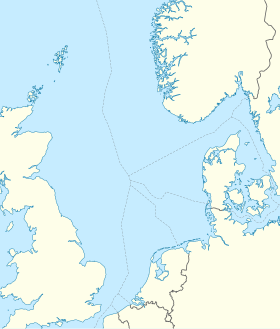Unterseeboot UB-63
| Unterseeboot UB-63 | ||
 L'UB-148 en mer, un U-boot similaire à l'UB-63 | ||
| Type | Sous-marin côtier | |
|---|---|---|
| Classe | UB III | |
| Histoire | ||
| A servi dans | ||
| Constructeur | AG Vulcan, Hambourg | |
| Commandé | 20 mai 1916[1] | |
| Lancement | 26 mai 1917[2] | |
| Commission | 23 juillet 1917[2] | |
| Statut | Coulé le 28 janvier 1918 par des navires de guerre britanniques[2] | |
| Équipage | ||
| Équipage | 3 officiers, 31 hommes | |
| Caractéristiques techniques | ||
| Longueur | 55,52 m | |
| Maître-bau | 5,76 m | |
| Tirant d'eau | 3,70 m | |
| Déplacement | ||
| Propulsion |
|
|
| Vitesse |
|
|
| Profondeur | 50 m | |
| Caractéristiques militaires | ||
| Armement |
|
|
| Rayon d'action |
|
|
| Pavillon | Empire allemand | |
| Localisation | ||
| Coordonnées | 56° 10′ nord, 2° 00′ est | |
| Géolocalisation sur la carte : mer du Nord
| ||
| modifier |
||
L'Unterseeboot UB-63 est un sous-marin (U-Boot) allemand de type UB III utilisé par la Kaiserliche Marine pendant la Première Guerre mondiale. Il a été mis en service dans la marine impériale allemande le 23 juillet 1917.
L'UB-63 a été coulé le 28 janvier 1918 par les navires de guerre britanniques HMS W.S. Bailey et HMS Fort George à 56° 10′ N, 2° 00′ E avec des grenades anti-sous-marines. Les 33 membres d’équipage ont péri dans l’attaque[2].
Conception
[modifier | modifier le code]Comme tous les sous-marins de type UB III, l'UB-63 avait un déplacement de 508 tonnes en surface et de 639 tonnes en immersion. Ses moteurs lui permettaient de naviguer à 13,3 nœuds (24,6 km/h) en surface et à 8 nœuds (15 km/h) en immersion. Il avait une autonomie de 8420 milles marins (15590 km) à sa vitesse de croisière. L'UB-63 transportait 10 torpilles et était armé d’un canon de pont de 8,8 cm. L'UB-63 avait un équipage pouvant compter jusqu’à 3 officiers et 31 hommes[3].
Carrière
[modifier | modifier le code]L'UB-63 a été commandé par le GIN le 20 mai 1916. Il a été construit par AG Vulcan à Hambourg. Après un peu moins d’un an de construction, il a été lancé à Hambourg le 26 mai 1917. L'UB-63 a été mis en service plus tard la même année.
Affectations
[modifier | modifier le code]- IIe flottille : du 4 au 30 septembre 1917
- V Flottille : du 30 septembre 1917 au 28 janvier 1918
Commandants
[modifier | modifier le code]- Kapitänleutnant Rudolf Gebeschus[4] : du 23 juillet 1917 au 28 janvier 1918
Navires coulés
[modifier | modifier le code]| Date | Nom | Nationalité | Tonnage | Destin[5]. |
|---|---|---|---|---|
| 15 septembre 1917 | Santaren | 4256 | Sunk | |
| 3 novembre 1917 | Haelen | 3290 | Capturé comme prise | |
| 8 novembre 1917 | Lindhardt | 225 | Coulé | |
| 15 novembre 1917 | Stargard | 1,113 | Endommagé |
Notes et références
[modifier | modifier le code]- (en) Cet article est partiellement ou en totalité issu de l’article de Wikipédia en anglais intitulé « SM UB-63 » (voir la liste des auteurs).
- Rössler 1979, p. 60.
- Gröner 1991, p. 25-30.
- Gröner 1991, p. 63.
- (en) Guðmundur Helgason, « Kapitänleutnant Rudolf Gebeschus - German and Austrian U-boats of World War One - Kaiserliche Marine », sur Uboat.net (consulté le ).
- (en) Guðmundur Helgason, « Ships hit by UB 63 », sur Uboat.net (consulté le ).
Bibliographie
[modifier | modifier le code]- (de) Harald Bendert, Die UB-Boote der Kaiserlichen Marine 1914-1918. Einsätze, Erfolge, Schicksal, Hambourg, Verlag E.S. Mittler & Sohn GmbH, (ISBN 978-3-8132-0713-2).
- (en) Erich Gröner, Dieter Jung et Martin Maass, German Warships 1815-1945 : U-boats and Mine Warfare Vessels, vol. 2, Londres, Conway Maritime Press, (ISBN 0-85177-593-4).
- (de) Eberhard Rössler, Die deutschen U-Boote und ihre Werften: eine Bilddokumentation über den deutschen U-Bootbau; in zwei Bänden, vol. I, Munich, Bernard & Graefe, (ISBN 3-7637-5213-7, lire en ligne).
Voir aussi
[modifier | modifier le code]Articles connexes
[modifier | modifier le code]Text is available under the CC BY-SA 4.0 license; additional terms may apply.
Images, videos and audio are available under their respective licenses.

